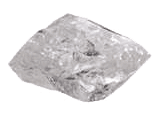| Gemstone Chart |
 Natural Alexandrite Natural Alexandrite
Alexandrite was discovered in 1830 in the Ural mountains of Russia. Alexandrite is also found in Sri Lanka, Brazil, India, Tanzania, Zimbabwe, and most recently in Madagascar. The alexandrite variety of chrysoberyl is one of the rarest and most sought after of all gems.
Color: changing from green to red
Categories: semi-precious stone
Chemical Composition: BeAl2O4
Crystal Group: Orthorhombic
Refractive Index: 1.741 - 1.760
Hardness: 8.50
Density: 3.73
Occurrence: Tanzania, India, Russia, Madagascar, Sri Lanka, Zimbabwe, Zambia
|  Natural Andalusite Natural Andalusite
Andalusite is popular as a collector stone but is seldom used in jewelry probably because of it's unavailability. With a hardness of 7 - 7.5 andalusite is tough enough to be used in jewelry. Andalusite, especially in the rough, can easily be confused with alexandrite because of similarities in color
Categories: semi-precious stone
Chemical Composition: Al2SiO5
Crystal Group: Orthorhombic
Refractive Index: 1.628 - 1.647
Hardness: 7 - 7.5
Density: 3.13 - 3.21
Occurrence: Brazil, Sri Lanka, Spain, East Africa, Burma, U.S.A.
|  Natural Chrysoberyl Natural Chrysoberyl
The Chrysoberyl family is best known for the more valuable alexandrite and catseye varieties. Faceted chrysoberyl is a beautiful gem which is not as well known in its own right. Apart from the high hardness, it takes a good polish and has a good luster.
Color: yellow, green, color changing, red, blue-green, greenish-yellow or brown
Categories: semi-precious stone
Chemical Composition: BeAl2O4
Crystal Group: Orthorhombic
Refractive Index: 1.741 - 1.760
Hardness: 8.5
Density: 3.73
Occurrence: Ceylon, Tanzania, Russia, Madagascar, Brazil.
|  Natural Chrysoberyl Cats Eye Natural Chrysoberyl Cats Eye
Chrysoberyl cats eye is a very rare and expensive gemstone which is found in small quantities in Sri-Lanka and Brazil. The cats eye is present because the stone has chatoyancy in its make up and this effect cause the ‘eye’ which moves as the gem is gently turned .
Color: yellow, greenish yellow, yellowish green
Categories: semi-precious stone
Chemical Composition: BeAl2O4
Crystal Group: Orthorhombic
Refractive Index: 1.741 - 1.760
Hardness: 8.5
Density: 3.73
Occurrence: Ceylon, Tanzania, Russia, Madagascar, Brazil.
|  Natural Danburite Natural Danburite
Danburite is a very spiritual stone that carries a pure vibration. With a hardness of 7, danburite is quite hard and suitable for any kind of jewelry. Danburite handles easily and ordinarily offers no problems for lapidaries. It makes an especially brilliant gem because of its extreme clarity.
Color: White, yellowish, very light pink, buff colored, very light brown
Categories: semi-precious stone
Chemical Composition: calcium borosilicate
Crystal Group: Orthorhombic
Refractive Index: 1.630(+.003,-.003) - 1.636 (+.003, -.003)
Hardness: 7
Density: 3
Occurrence: Danbury, Connecticut and Russell, New York, USA; Charcas, San Luis Potosi, Mexico; Kyushu Island, Japan; Mogok, Burma and Uri, Switzerland; Madagascar.
|  Natural Enstatite Natural Enstatite
Enstatite is a relatively common mineral, but is rarely used for jewelry purposes. It is generally cut for gem connoisseurs and collectors rather than for the common consumer.
Color: Gray, green, brown, orange-brown, yellowish-brown, colorless, pale yellow.
Categories: semi-precious stone
Chemical Composition: MgSiO3
Crystal Group: Orthorhombic
Refractive Index: 1.663-1.673
Hardness: 5.5
Density: 3.26-3.28
Occurrence: South Africa, Burma, Tanzania, Sri Lanka, Kenya, Germany, Norway, Greenland
|  Natural Hemimorphite Natural Hemimorphite
Hemimorphite is a usually white or colorless mineral, essentially Zn4Si2O7(OH)2·H2O, an important ore of zinc. Also called calamine.
Color: Light blue, dark blue, green ,white.
Categories: semi-precious stone
Chemical Composition: (Zn4Si2O7(OH)2.H2O)
Crystal Group: Orthorhombic
Refractive Index: 1.612-1.633
Hardness: 5
Density: 3.44
Occurrence: Franklin and Sterling Hill New Jersey, New Mexico, Montana, Arizona, U.S.A; Congo; Nerchinak in Transbaikalia, Siberia; Zambia; Santa Eulalia and Mapimi, Mexico; England; Wenshan, Yunnan Province, China.
|  Natural Iolite Natural Iolite
Iolite is a popular and interesting gemstone, and is the gem variety of the mineral cordierite.It has also been called water sapphire because it looks very much like a blue sapphire.
Color: violet, blue, dark blue,
Categories: semi-precious stone
Chemical Composition: MG2AL4SI5O18
Crystal Group: Orthorhombic
Refractive Index: 1.53 - 1.55
Hardness: 7 - 7.5
Density: 2.57 - 2.66
Occurrence: Sri Lanka; Burma; India; Tsivory,Madagascar; Canada; Namibia; Tanzania; Norway; U.S.A.; Brazil
|
|
